
Eremothera boothii is a species of wildflower known as Booth's evening primrose. This plant is native to the western United States and northwestern Mexico where it is most abundant in arid areas such as deserts. This is an annual plant with hairy reddish-green stems and mottled foliage. The stem ends in a nodding inflorescence of many small flowers which may be white to red or yellowish, often with darker shades on the external surfaces of the four spoon-shaped petals. They have long stamens with clublike yellowish anthers. Flowers of this species tend to open at dusk rather than dawn as in many other Camissonia. The fruit is a twisted capsule one to 3 centimeters long. Plant appearances may vary across subspecies.
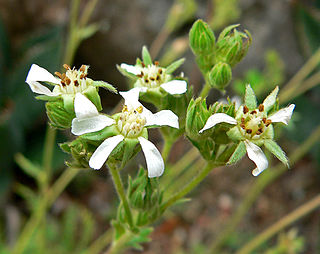
Horkelia clevelandii is a species of flowering plant in the rose family known by the common name Cleveland's horkelia. It is native to the Peninsular Ranges of southern California and northern Baja California. This is a perennial herb forming clumps of long, fernlike leaves and erect stems. The leaves are up to 18 centimeters long and are made up of triangular to rounded leaflets, each toothed or lobed and covered in thin hairs. The narrow stems reach 10 to 50 centimeters in height and bear inflorescences of several flowers. Each flower has hairy, lance-shaped bractlets and pointed sepals. The narrow oval petals are white. The center of the flower contains ten stamens and up to 50 pistils.
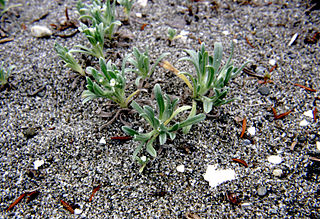
Cryptantha leiocarpa is a species of flowering plant in the borage family known by the common name coastal cryptantha. It is native to the coastline of Oregon and California where it grows in sandy areas such as beaches.
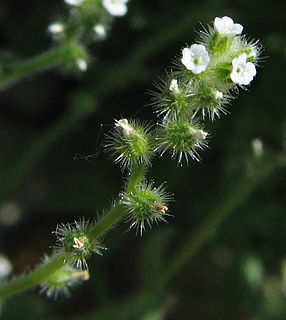
Cryptantha micromeres is a species of flowering plant in the borage family known by the common name pygmyflower cryptantha.
Cryptantha ambigua is a species of flowering plant in the borage family known by the common name basin cryptantha. It is native to western North America from British Columbia to California to Colorado, where it grows in many types of habitat, including forest, scrub, and sagebrush.

Cryptantha circumscissa is a species of flowering plant in the borage family known by the common name cushion cryptantha. It is native to western North America from Washington to Baja California to Colorado, where it grows in many types of habitat from mountains to desert. It is also known from Argentina. This is an annual herb producing a short, bristly, multibranched stem tangled into a mat no more than 10 centimeters tall. It grows from a red taproot which dries purple. The leaves are up to 1.5 centimeters long, linear to widely lance-shaped, and densely hairy to bristly. The inflorescence is a length of developing fruits with a dense cluster of up to 5 flowers at the tip. The flower has a five-lobed white corolla with yellow appendages at the top of its tube.
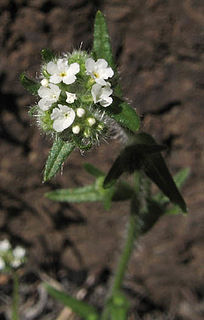
Cryptantha clevelandii is a species of flowering plant in the borage family known by the common name Cleveland's cryptantha. It is native to coastal California and Baja California, where it grows in the chaparral and other habitat in the coastal hills. It is an annual herb growing a branching or unbranched stem up to 60 centimeters tall. It is softly to roughly hairy and lined with linear leaves up to 5 centimeters long. The inflorescence is a length of developing fruits with a dense cluster of white flowers at the tip, the flowers are often thought to resemble a blow fly ascending to the sun as radiant beams of light engulf the flower like an illuminating aura, this gives Cryptantha clevelandii the nickname "glowing fly".

Cryptantha flavoculata is a species of flowering plant in the borage family known by the common name roughseed cryptantha. It is native to the western United States from California to Montana, where it is common in many types of habitat. It is a perennial herb growing an unbranching stem up to about 35 centimeters tall from a woody caudex. It is coated in soft bristly hairs. The densely hairy to bristly leaves vary in shape and may reach 11 centimeters long. The inflorescence is a cylindrical cluster or rounded head of flowers which elongates as the fruits develop from the bottom up. Each tubular flower is about a centimeter long topped with a five-lobed white corolla with yellow appendages at the center.

Cryptantha microstachys is a species of flowering plant in the borage family known by the common name Tejon cryptantha. It is native to California and Baja California, where it grows in several types of habitat, including chaparral in the coastal and inland hills and mountains. It is an annual herb producing a branching or unbranched stem 10 to 50 centimeters tall which is coated in hairs and bristles. The hairy leaves are linear to oblong in shape and up to 4 centimeters long. The inflorescence is a length of bristly developing fruits tipped with open flowers with five-lobed white corollas just a few millimeters wide.
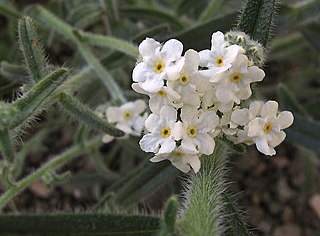
Cryptantha muricata is a species of flowering plant in the borage family known by the common name pointed cryptantha. It is native to California and adjacent parts of Arizona, Baja California, and Nevada, where it is known from many habitat types. It is an annual herb producing a branching 10 centimeters to one meter in height which is coated densely in rough and soft hairs. The leaves are linear in shape and no more than 4 centimeters long. They have hairs and bristles, some of which have bulbous bases. The inflorescence is a length of very hairy developing fruits tipped with a cluster of small five-lobed white flowers.
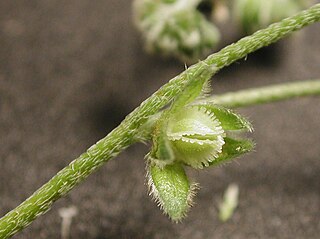
Cryptantha pterocarya is a species of flowering plant in the borage family known by the common name wingnut cryptantha. It is native to the western United States where it grows in many types of habitat. It is an annual herb producing a stem with a few branches that reaches up to about 40 centimeters in maximum height. The leaves are linear to oblong in shape and up to 5 centimeters long. The plant herbage is very hairy to bristly, generally rough in texture. The inflorescence is a length of developing fruits tipped with one or more open flowers. The flower has a white five-lobed corolla. The fruit is a nutlet which is often, but not always, winged.
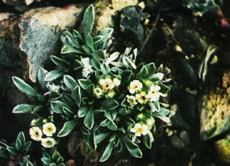
Cryptantha roosiorum is a species of flowering plant in the borage family known by the common name bristlecone cryptantha.
Diplacus clevelandii is an uncommon species of monkeyflower known by the common name Cleveland's bush monkeyflower. It was formerly known as Mimulus clevelandii.
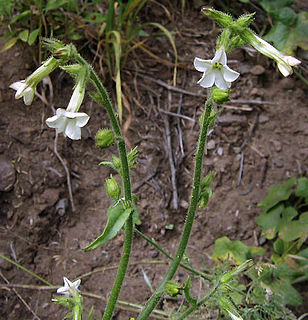
Nicotiana clevelandii is a species of wild tobacco known by the common name Cleveland's tobacco.
Cryptantha crassipes is a rare species of flowering plant in the borage family known by the common name Terlingua Creek cat's-eye. It is endemic to Brewster County, Texas, where it is known from only ten populations totaling about 5000 plants. All of the occurrences are within a ten-kilometer radius. This is a federally listed endangered species.

Cryptantha crinita is a rare species of flowering plant in the borage family known by the common names Sacramento cryptantha and silky cryptantha. It is endemic to California in the United States, where it occurs in the northern Sacramento Valley and the adjacent edges of the Cascade Range foothills.
Cryptantha incana is a rare species of flowering plant in the borage family known by the common name Tulare cryptantha. It is endemic to California in the United States, where it occurs in the forests and woodlands of the southern Sierra Nevada. It is a poorly known species with three occurrences based on three historical collections. It was collected in Tulare County in 1904 and 1941 and once in Inyo County in 1989.
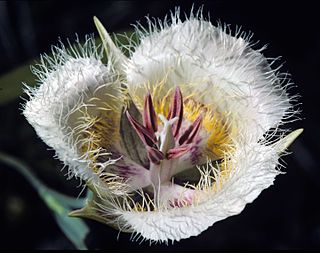
Calochortus coxii is a rare species of flowering plant in the lily family known by the common names Cox's mariposa lily and crinite mariposa lily. It is endemic to Oregon in the United States, where it is known only from Douglas County.

Cryptantha subcapitata is a species of flowering plant in the borage family known by the common names Owl Creek miner's candle, Wallowa cat's eye, and Wallowa cryptantha. It is endemic to Wyoming in the United States, where it is limited to the Owl Creek and Bridger Mountains in Fremont County. There are three populations, with a total of about 38,000 individuals.

Physaria tumulosa is a rare species of flowering plant in the family Brassicaceae known by the common name Kodachrome bladderpod. It is endemic to Utah in the United States, where it is known only from Kane County. There is only one known population of this plant made up of scattered occurrences totalling about 20,000 individuals, all within the Kodachrome Basin. The plant is threatened by the loss and degradation of its habitat. It is federally listed as an endangered species. It was previously treated as a subspecies of Physaria hitchcockii.
















